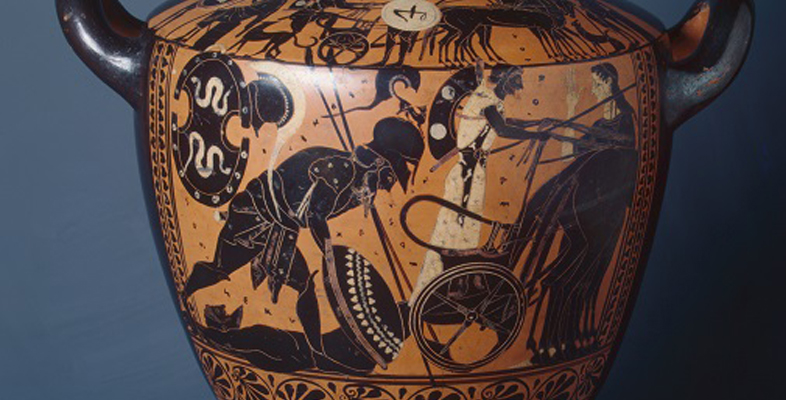4.1 Insightful similes
But the similes in the Iliad are not only interesting for their vividness, universality, and for reflecting on the greater theme of war. By deploying similes at key points in his story, Homer reveals important insights into not only the world of his audience, but also his characters.
Activity 12
Read these two similes, which both describe Agamemnon. What sort of characteristics do they suggest about him in each instance?
First simile:
When the Trojans reached the Scaean gates and the oak tree,
there they halted and stood, waiting for one another;
many were still fleeing in panic over the mid-plain, like cattle
stampeded by a lion that has come on them in the dead of night;
the rest have scattered, and one alone faces sheer death, and
first the lion seizes the neck in its powerful jaws and breaks it,
and then greedily gulps down its blood and all its entrails.
So lord Agamemnon, son of Atreus, pursued the Trojans,
all the time killing the hindmost; and they fled in panic.
Second simile:
Now the son of Atreus, so long as the blood welled up warm
from his wound, went up and down the Trojan ranks,
attacking them with spear and sword and great stones;
but when the wound began to dry, and the blood stopped flowing,
then sharp pains began to assail the fury of Atreus’ son.
As when a sharp spasm seizes a woman in labour, a piercing
pang, sent by the Eilythyiae, goddesses of painful birth,
bringers of bitter suffering and daughters of Hera,
so sharp pains began to assail the fury of Atreus’ son.
Discussion
The first simile compares Agamemnon to a lion pursuing a herd of cattle (the Trojans). He appears to be a powerful and terrifying figure, and an obvious predator to the prey of the Trojan army. He seems to cause death and destruction easily, particularly for any Trojans who lag behind. This is Agamemnon portrayed as an unstoppable, intimidating fighting force.
By contrast, the second simile compares Agamemnon after he has been wounded to a woman in childbirth. Agamemnon appears to be in great pain here, and perhaps in a state of vulnerability. The comparison with a woman could be seen as a slight to a warrior of Agamemnon’s calibre.
It’s particularly interesting to note that these two similes appear in close proximity to each other in book 11. The difference between the two similes marks a change in Agamemnon’s role on the battlefield during this episode, from an aggressive and powerful warrior to a wounded and weakened figure. From a modern perspective, we might not see the comparison with a woman in labour as particularly detrimental to Agamemnon’s character, but for the ancient audience this might have had a different resonance, as men and women occupied very different spheres. To compare him to a woman may have, at the very least, had the effect of showing that his wound has prevented him from fulfilling his duty as a male warrior, and could also serve as an ironic commentary on his self-styled misogyny elsewhere in the poem.
The simile comparing Patroclus and a little girl from Activity 11 also gives an interesting perspective on character. In spite of the fact that Achilles makes a comparison which could be seen as diminishing Patroclus’ status as a warrior, and which seems to mock Patroclus to some extent, Achilles stillreluctantly agrees to let Patroclus fight in his stead. The humble simile helps to humanise Achilles at this critical moment (one that will have devastating consequences) and allows us a way into his mind-set. Ironically, the heroic world has to be supplemented by images from the real world in order to convey its magnitude.
This section has examined just a few of the many similes that appear in the Iliad, and which are a distinctive part of the poem’s style. Many of their effects would have been particularly potent in oral performance – especially the creation of enargeia for the listeners – but others, such as reflections on characters and themes, are equally effective in the written format in which most people experience the poem today.
